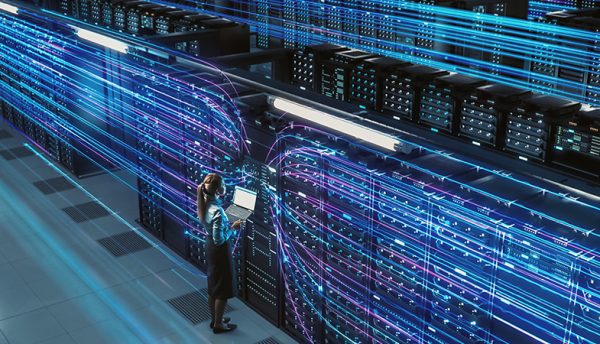Embarking on a transformative journey into 2024, the data centre landscape gears up for unparalleled growth and innovation. From a relentless focus on power and energy to the intricate interplay of geopolitics and green reporting, the industry faces a pivotal year where strategic choices will shape the future of infrastructure. Mark Kidd, EVP & GM, Iron Mountain Data Centers and Asset Lifecycle Management, tells us more.
It’s been an exceptional year for data centre growth, and it looks like 2024 will be the same but with new and more creative approaches to supply. Power will continue to be the primary focus, with pressure on electrical grids driving new investment in generation components, hubs and energy sources. Geopolitics will also enter the equation, combining with climate reporting legislation to make granular reporting of everything from raw materials to CUE an urgent task.
Digital momentum
According to Cushman & Wakefield, early investment in power-hungry Generative AI drove phenomenal growth last year with as much as 50% in additional global capacity delivered in a single year. A lot of negative economic forecasts failed to come true and business fundamentals are still strong.
On top of this, Gartner forecasts an 8% uptick in IT spending after a sluggish few years which will drive hardware consumption, while organisations look towards practical benefits from AI – such as streamlining and productivity. Particular growth sectors to look out for in 2024 include government, defence and healthcare, which for the first time ever accounts for over 10% of global GDP.
The ‘Great Power Grab’
How will supply match demand this year? The last 6-12 months’ available data centre capacity, which was already limited, has been soaked up by the giant power sponge of AI planning. It’s inevitable that AI will lead to design impacts on data centres, as well as new patterns of development where large-scale, more remote AI training sites contrast with AI inference (delivery) sites close to users.
Even if the demand for AI capacity slows – and there is no sign of this – replenishment of capacity will not be able to keep pace with demand, particularly in Tier 1 regions. But the market dislikes a vacuum and new entrants are looking to make the most of the opportunity this presents. Established operators are still managing to turn up or fast-track opportunities from their portfolio, as we are doing in Miami. Powering land has also attracted some speculators as the demand and returns are high. This will likely lead to the identification of new capacity zones outside the most developed markets.
Major new global fibre routes will also come online this year, accelerating performance and creating opportunities. New cable projects are underway to add higher performance and redundancy and lower costs in the Middle East, particularly for backup around the Suez Canal, a well-known connectivity pinch point. Both the Africa-1 and 2Africa subsea cables will also complete, speeding traffic between Africa, Europe and the Middle East. New data handling hubs are bound to pop up around multiple landing points.
Carbon crossroads
An 11% climb in renewables use is expected, but they will still only account for 14% of global total energy use. There is a long way to go to reduce emissions, and temperatures continue to rise, with the 1.5°C ‘global warming ceiling’ identified in the Paris Agreement approaching fast.
Around US$4 trillion per year will be required to upgrade the electrical grid as the global transition to low-carbon electricity speeds up. The need for data centre power is now creating competition for key power-generation components including utility scale transformers.
Considering this pressure on the green grid, some data centre operators may be tempted to select transitional solutions such as gas, but these factors delay addressing the core problem which is total decarbonisation. Moving beyond the Virtual Power Purchase Agreement to round-the-clock direct use of zero-carbon power is the long-term solution. While implementing full #247CFE will take time, this is even more reason to start early; if we don’t restructure power sourcing site by site, measure, track and improve it, we will never get there. The gulf between short-term and long-term power strategies will widen in 2024, raising questions for the industry and its customers.
Geopolitics meets green reporting
Geopolitics will add its weight to a new sheaf of global, US and EU climate reporting requirements to demand much higher levels of transparency in 2024. As well as critical components like semiconductors and GPUs, geographical provenance will be required right down to the raw material level for government contracts, and the industry will diversify its supply chains fast in areas like Vietnam, Eastern Europe, Mexico and India.
The rare-earth mining and processing industry will experience significant changes as these elements are critical to national security, energy independence and the environment, and demand for recovery of rare-earth minerals will continue to rise. Greater transparency will also be required to meet new climate reporting regulations across the full asset lifecycle, from production to retirement to reuse, as environmental impact targets broaden to take account of Scope 3 emissions.
Opportunism with an eye to the long term
2024 looks like an exciting year with lots to play for and developments that will change the data centre landscape. Creative site selection and speed to market will have major impacts on the bottom line, while geopolitical considerations and new regulations put both forward and reverse supply chains under the spotlight. For infrastructure operators, getting the balance right between short-term opportunism and long-term systemic improvements will be key.
Click below to share this article


